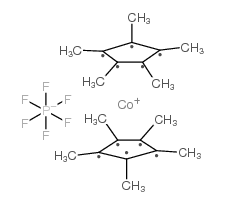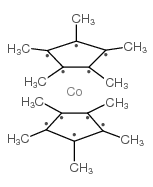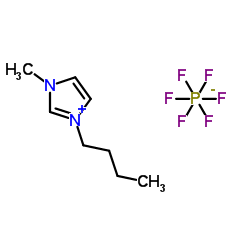79973-42-5
| Name | bis(pentamethylcyclopentadienyl)cobalt(iii) hexafluorophosphate |
|---|---|
| Synonyms |
DECAMETHYLCOBALTOCENIUM HEXAFLUOROPHOSPHATE
MFCD00269818 decamethylcobalticinium hexafluorophosphate decamethylcobaltocinium hexafluorophosphate |
| Melting Point | 305ºC |
|---|---|
| Molecular Formula | C20H30CoF6P |
| Molecular Weight | 474.35000 |
| Exact Mass | 474.13200 |
| PSA | 13.59000 |
| LogP | 9.32640 |
|
Section 1: Product Identification Chemical Name:Bis(pentamethylcyclopentadienyl)cobalticinium hexafluorophosphate, 98% CAS Registry Number:79973-42-5 Formula:[(CH3)5C5]2Co+PF6- EINECS Number:none Chemical Family:metallocene Synonym:none
Section 2: Composition and Information on Ingredients IngredientCAS NumberPercentACGIH (TWA)OSHA (PEL) Title Compound79973-42-5100%0.02mg/m3 (as Co)no data Section 3: Hazards Identification Causes irritation of eyes, skin, and respiratory tract. May cause lung disease, polycythemia, congestive failure, Emergency Overview: and enlargement of the thyroid. Limited evidence of a carcinogenic effect. Primary Routes of Exposure:Skin and eyes, ingestion and dust inhalation. Eye Contact:Causes irritation, redness, and pain. Skin Contact:May cause dermatitis. Causes irritation to skin. Symptoms include redness, itching, and pain. Causes irritation to the respiratory tract. Symptoms may include coughing, shortness of breath, nausea, Inhalation: respiratory hypersensitivity, asthma. Causes abdominal pain, nausea, vomiting, flushing of the face and ears, mild hypo tension, rash, and ringing Ingestion: in the ears. Irritating to skin, eyes and respiratory tract. Causes abdominal pain, nausea, vomiting, coughing, and Acute Health Affects: shortness of breath. Repeated oral administration of cobalt salts may reduce thyroid activity, cause blood disease, and damage Chronic Health Affects:kidney, heart and lungs. Prolonged or repeated skin exposure may cause dermatitis. Limited evidence of a carcinogenic effect. NTP:No IARC:No OSHA:No SECTION 4: First Aid Measures Immediately flush the eyes with copious amounts of water for at least 10-15 minutes. A victim may need Eye Exposure: assistance in keeping their eye lids open. Get immediate medical attention. Wash the affected area with water. Remove contaminated clothes if necessary. Seek medical assistance if Skin Exposure: irritation persists. Remove the victim to fresh air. Closely monitor the victim for signs of respiratory problems, such as difficulty Inhalation: in breathing, coughing, wheezing, or pain. In such cases seek immediate medical assistance. Seek medical attention immediately. Keep the victim calm. Give the victim water (only if conscious). Induce Ingestion: vomiting only if directed by medical personnel. SECTION 5: Fire Fighting Measures Flash Point:not applicable Autoignition Temperature:none Explosion Limits:none Extinguishing Medium:carbon dioxide, foam or dry powder If this product is involved in a fire, fire fighters should be equipped with a NIOSH approved positive pressure Special Fire Fighting Procedures: self- contained breathing apparatus and full protective clothing. Hazardous Combustion andIf involved in a fire this material may emit toxic organic fumes and vapors of phosphorus pentoxide. Decomposion Products: Unusual Fire or Explosion Hazards: No unusual fire or explosion hazards. SECTION 6: Accidental Release Measures Small spills can be mixed with vermiculite, sodium carbonate or other suitable non combustible adsorbent and Spill and Leak Procedures: swept up. SECTION 7: Handling and Storage Handling and Storage:Store in a cool, dry area away from heat and direct sunlight. SECTION 8: Exposure Controls and Personal Protection Eye Protection:Always wear approved safety glasses when handling a chemical substance in the laboratory. Skin Protection:Wear protective clothing and gloves. Ventilation:Material may form a fine dust. If possible, handle the material in an efficient fume hood. If ventilation is not available a respirator should be worn. The use of respirators requires a Respirator Respirator: Protection Program to be in compliance with 29 CFR 1910.134. Ventilation:Material may form a fine dust. If possible, handle the material in an efficient fume hood. Additional Protection:No additional protection required. SECTION 9: Physical and Chemical Properties Color and Form:yellow to orange pwdr. Molecular Weight:474.35 Melting Point:no data Boiling Point:no data Vapor Pressure:no data Specific Gravity:no data Odor:none Solubility in Water:slightly soluble SECTION 10: Stability and Reactivity Stability:air and moisture stable Hazardous Polymerization:no hazardous polymerization Conditions to Avoid:none Incompatibility:Oxidizing agent and halogens Decomposition Products:Cobalt oxide, phosphorus pentoxide, and hydrogen fluoride. SECTION 11: Toxicological Information RTECS Data:No specific information available on this product. Carcinogenic Effects:Possible carcinogen (as Co) Mutagenic Effects:No data Tetratogenic Effects:No data SECTION 12: Ecological Information Ecological Information:No information available SECTION 13: Disposal Considerations Disposal:Dispose of according to local, state and federal regulations. SECTION 14: Transportation Shipping Name (CFR):Non-hazardous Hazard Class (CFR):NA Additional Hazard Class (CFR):NA Packaging Group (CFR):NA UN ID Number (CFR):NA Shipping Name (IATA):Non-hazardous Hazard Class (IATA):NA Additional Hazard Class (IATA):NA Packaging Group (IATA):NA UN ID Number (IATA):NA SECTION 15: Regulatory Information TSCA:Not listed in the TSCA inventory. SARA (Title 313):Title compound: See category N096 for reporting. Second Ingredient:None SECTION 16 - ADDITIONAL INFORMATION N/A |
| Hazard Codes | C: Corrosive; |
|---|---|
| Risk Phrases | R14 |
| Safety Phrases | 26-27-36/37/39-45 |
| RIDADR | UN 3260 8/PG 3 |
| Packaging Group | III |
|
~% 
79973-42-5 |
| Literature: Chemical Communications, , # 33 p. 3467 - 3469 |



